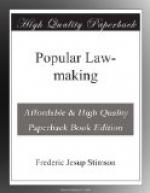was suddenly removed; of such nature must be the justification,
if any, for bounties given in times of flood, fire,
or public disaster, which, however, are really sustained
only in the absence of objection and on the principle
lex non curat de minimis. The most insidious
form of the bounty, however, is that of exemption
from taxation, or, still worse, granting subsidies
or subscribing to the stock and bonds of public-service,
or even ordinary private, corporations. Undoubtedly
the exception has been established in the case of railroads.
The granting of State, city, or county aid to railroads
has existed almost from their invention, probably
on the analogy of highways; at all events, it is too
late to be constitutionally questioned now. The
exemption from taxation of private profitable enterprises,
such as mills or factories, is less defensible.
Frequently, however, they go without question, it
being to no one’s particular interest to do so.
The usual subjects of State bounties were, in 1890,
beet-root sugar, binding twine, iron and iron pipe,
potato starch, and rope, with tax exemptions to Portland-cement
works. Ramie fibre continued a favorite subject
of bounty for some years, with seed distributions to
farmers, which were in some States held unconstitutional.
In 1896 Utah gave a bounty on canaigre leather and
silk culture. There was an exemption on salt
plants in Michigan, but beet sugar continued the favorite
beneficiary. There has been a reaction against
bounty legislation of recent years. In 1908,
for instance, New York repealed its bounty on beet
sugar, and it may be hoped, with greater intelligence
of constitutional principles, that all such legislation
will be abandoned.
Coming to matters of ordinary taxation, of course
the first thing to note is its extraordinary extent.
In direct taxation it is not an unfair estimate to
say that the States and their municipal organizations
undertake to impose an annual assessment on real and
personal property which would average at least two
per cent. throughout the country; amounting to from
one-third to one-half of the income derived therefrom.
In indirect taxation, duties, and revenue taxes, a
sum far greater is taken from the average household.
One might very much wish that the individual householder
might at least know how large a sum is thus taken
from his earnings annually, for it is safe to say
that in no civilized country, not even in the France
before the Revolution, was individual taxation anything
like so heavy. Therefore, we are beginning to
find legislation, even constitutional provisions,
carefully limiting the tax rate. The amount of
the State tax is thus limited in probably half the
States, mostly Southern or Western, and nearly all
of them limit also the amount of taxation to be imposed
by the counties, cities, towns, school districts, or
for other special purposes. In the North-eastern
States such limitation is not usual, though in Massachusetts
and New York it exists as to certain cities.




